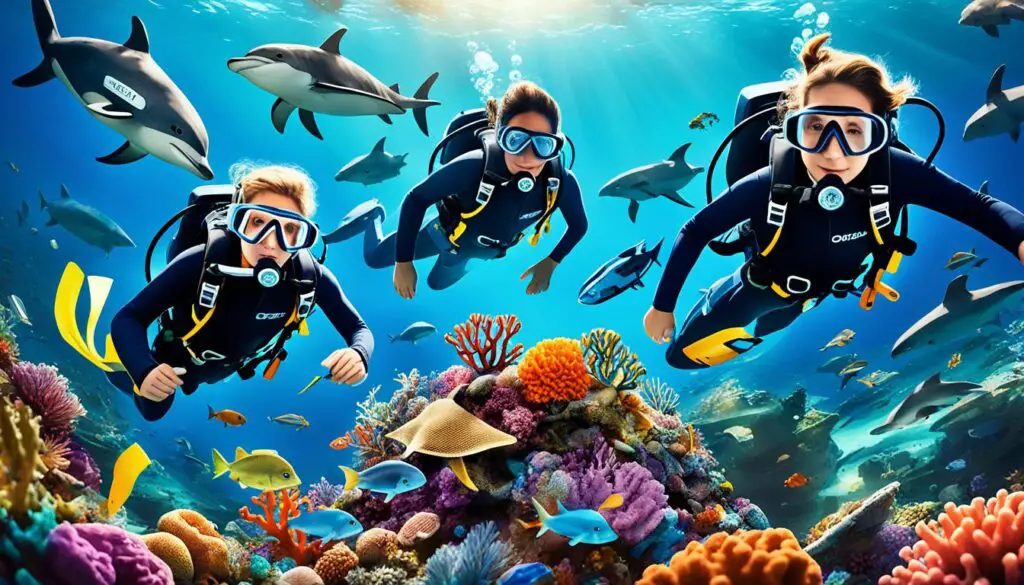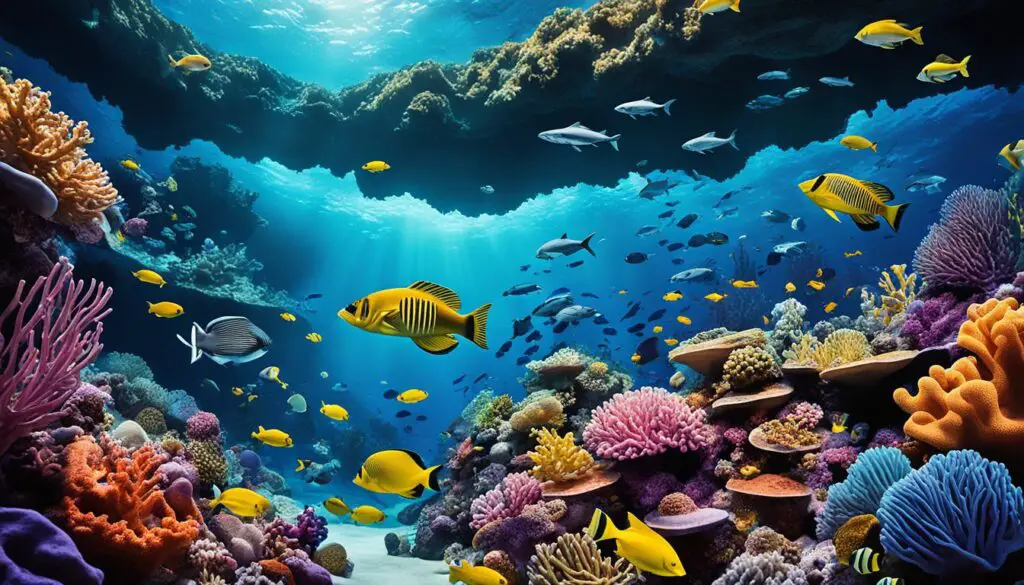I am thrilled to share with you the groundbreaking initiative launched by the National Geographic Society – the Wildlife Intelligence Project. This ambitious project aims to delve deep into the world of animal cognition and behavior, revolutionizing our understanding of wildlife and how we connect with it.
Inspired by the remarkable work of Dr. Jane Goodall, the project has handpicked three rising stars in the field of animal research. These scientists are poised to unravel the mysteries of animal intelligence and behavior, answering fundamental questions and reshaping our relationship with the natural world.
Key Takeaways:
- The Wildlife Intelligence Project by the National Geographic Society is a groundbreaking initiative focused on animal cognition and behavior.
- The project aims to revolutionize our understanding of wildlife and how we connect with it.
- Three exceptional scientists have been selected to unravel the mysteries of animal intelligence and behavior.
- Their discoveries will provide invaluable knowledge for both the scientific community and humanity as a whole.
- The Wildlife Intelligence Project is a quest to rediscover our place within the tapestry of life on Earth.
Dr. Jane Goodall’s Inspiring Works
Dr. Jane Goodall, a visionary primatologist, has played a crucial role in inspiring the Wildlife Intelligence Project. The project’s goal is to unlock the secrets of the animal mind and foster a deeper connection with the creatures we share the planet with.
Dr. Goodall’s groundbreaking research on chimpanzees has revolutionized our understanding of animal intelligence and behavior. Her pioneering studies on the social and cognitive abilities of these incredible creatures have unveiled a world of complexity and emotion that was previously unknown.
Furthermore, Dr. Goodall’s exceptional contributions have been recognized and celebrated. She is the recipient of numerous accolades, including the prestigious Templeton Prize for her extraordinary efforts to explore the interconnections between science, spirituality, and nature. This recognition highlights the significance of her work and the impact it has had on shaping our understanding of the animal mind.
The Wildlife Intelligence Project is built upon the foundation laid by Dr. Goodall’s legacy. Inspired by her dedication, the chosen explorers are driven by curiosity, purpose, and the desire to continue pushing the boundaries of our knowledge. Their work aims to uncover the depths of animal intelligence, offering us a glimpse into the fascinating world of the animal mind.
By studying the behaviors, social interactions, and cognitive abilities of various animal species, the Wildlife Intelligence Project hopes to cultivate a greater appreciation for the intricacies of the natural world. Through their efforts, the project seeks to foster empathy and understanding towards animals, promoting a sense of stewardship and inspiring positive change.
“In the end, we will conserve only what we love; we will love only what we understand, and we will understand only what we are taught.” – Dr. Jane Goodall
Future Champions of Conservation
The Wildlife Intelligence Project, spearheaded by the National Geographic Society, has handpicked three exceptional scientists who are set to become the future champions of conservation. These individuals, driven by passion and a deep desire to protect and understand wildlife, will shed light on the intricacies of animal behavior and cognition.
Exploring Cooperative Behavior in Dolphins
Mauricio Cantor, a Brazilian biologist, will focus his research on studying cooperative behavior between dolphins and humans across different locations. By delving into the dynamics of these interactions, Cantor aims to uncover the complex social structures and communication systems that facilitate cooperation between these intelligent marine creatures.
Unraveling the Behavior of Wild Bees
Felicity Muth, the head of the Muth Lab, has dedicated her work to understanding how ecology shapes the behavior of wild bees. By investigating the intricate relationships between bees and their environment, Muth aims to gain insights into their foraging patterns, communication methods, and overall ecological impact. Her research will contribute to the conservation efforts aimed at protecting these vital pollinators.
Delving into the Tool-Use Behaviors of Capuchin Monkeys
Tiago Falótico, a primatologist, will delve into the tool-use behaviors of wild capuchin monkeys. Fascinated by their remarkable problem-solving abilities, Falótico aims to unravel the cognitive processes that drive these behaviors and explore how cultural transmission shapes the tool-use techniques among different capuchin monkey communities.
“Through our research, we hope to not only deepen our understanding of these incredible creatures but also to raise awareness about the importance of their conservation. By unraveling the mysteries of animal behavior, we can pave the way for more effective conservation strategies and ensure a harmonious coexistence between humans and wildlife.”
Highlighted by the inspiring work of Dr. Jane Goodall, the Wildlife Intelligence Project aims to revolutionize our understanding of animal intelligence and behavior. Through the groundbreaking research conducted by Mauricio Cantor, Felicity Muth, and Tiago Falótico, we gain new insights into cognition, cultural transmission, and the ecological impact of animals.
Join us in supporting these future champions of conservation as they advance our knowledge and pave the way for a more sustainable future.

The Future of Wildlife Study
The Wildlife Intelligence Project is at the forefront of revolutionary research, aiming to transform our understanding of the animal mind and reshape our relationship with the natural world. Through the groundbreaking work conducted by the chosen explorers, we are unlocking the secrets of animal intelligence and expanding our horizons.
One of the core objectives of the Wildlife Intelligence Project is to foster empathy and respect for all creatures. By learning from animals and appreciating their brilliance, we can develop a deeper sense of connection and appreciation for the natural world. This project highlights the importance of protecting their existence alongside our own, recognizing the interconnectedness of all species.
As we delve deeper into the study of the animal mind, we are rediscovering our place within the tapestry of life on Earth. The Wildlife Intelligence Project presents an opportunity to explore the wonders of animal cognition, cultural transmission, and ecological impact. Through this quest, we are not only gaining knowledge but also gaining a renewed sense of wonder and awe for the diversity of life that surrounds us.
Empathy: The Bridge Between Species
Empathy is a crucial aspect of the Wildlife Intelligence Project’s research. By understanding animal emotions and how they perceive the world, we can bridge the gap between species and develop deeper connections. The empathetic lens through which we approach our study allows us to appreciate the unique qualities of animals, their communities, and their contributions to the ecosystem.
Through empathy, we can transcend our own human biases and begin to see animals as more than just resources or objects of study. It enables us to recognize their inherent value and to advocate for their well-being.
By embracing empathy, we can coexist harmoniously with the animal kingdom and work towards a future where both humans and animals thrive. The Wildlife Intelligence Project is not only paving the way for scientific advancements but also serving as a call to action for conservation and environmental stewardship.

Comparative Insights into Animal Intelligence
| Species | Research Focus | Key Findings |
|---|---|---|
| Chimpanzees | Tool Use & Social Behavior | Chimpanzees have demonstrated remarkable problem-solving skills and the ability to use tools in various contexts. Their social structures and relationships exhibit complex dynamics and similarities to human societies. |
| Dolphins | Communication & Cooperation | Dolphins have showcased advanced communication systems and cooperative behaviors, highlighting their intelligence and ability to work collaboratively in complex tasks. |
| Capuchin Monkeys | Tool Use & Cultural Transmission | Capuchin monkeys have exhibited sophisticated tool-use behaviors and the transmission of cultural knowledge across generations, demonstrating their ability to learn and adapt from one another. |
| Elephants | Cognition & Emotional Intelligence | Elephants possess highly developed cognitive abilities and emotional intelligence, showcasing traits such as self-awareness, empathy, and long-term memory. |
Conclusion
The National Geographic Society’s Wildlife Intelligence Project represents a groundbreaking endeavor in oceanic exploration and wildlife conservation. Through the project’s exploration of the animal mind, our understanding of animal intelligence and behavior is being redefined, allowing us to truly appreciate the wonders of the natural world.
Inspired by the legacy of Dr. Jane Goodall, the chosen explorers are paving the way for invaluable knowledge that extends beyond the scientific community. Their work will benefit all of humanity, guiding us towards a future where both nature and humanity can thrive in harmony.
With each monumental discovery made by these explorers, we are brought one step closer to a world where wildlife conservation reaches new heights. Through the efforts of the Wildlife Intelligence Project and the National Geographic Society, we have the opportunity to reshape our relationship with the Earth and ensure a sustainable future for generations to come.
FAQ
What is the Wildlife Intelligence Project?
The Wildlife Intelligence Project is a groundbreaking initiative launched by the National Geographic Society. It aims to delve deep into the world of animal cognition and behavior, transforming our understanding of wildlife and how we connect with it.
Who inspired the Wildlife Intelligence Project?
Dr. Jane Goodall, a visionary primatologist, inspired the Wildlife Intelligence Project. Her groundbreaking research on chimpanzees and recognition, such as the Templeton Prize, have paved the way for this new generation of scientists.
Who are the scientists chosen for the project?
The Wildlife Intelligence Project selected three exceptional scientists: Mauricio Cantor, a Brazilian biologist studying cooperative behavior between dolphins and humans; Felicity Muth, head of the Muth Lab, exploring how ecology shapes the behavior of wild bees; and Tiago Falótico, a primatologist focused on the tool-use behaviors of wild capuchin monkeys.
What is the goal of the Wildlife Intelligence Project?
The goal of the Wildlife Intelligence Project is to change how we view animals and ourselves. It aims to expand our understanding of animal intelligence and behavior, fostering empathy and respect for all creatures and highlighting the importance of protecting their existence alongside our own.
How does the Wildlife Intelligence Project contribute to wildlife conservation?
The groundbreaking research conducted by the chosen explorers not only expands our understanding of the animal mind but also reshapes our relationship with the natural world. By fostering a deeper connection and appreciation for wildlife, the project emphasizes the need for conservation and a sustainable future.
